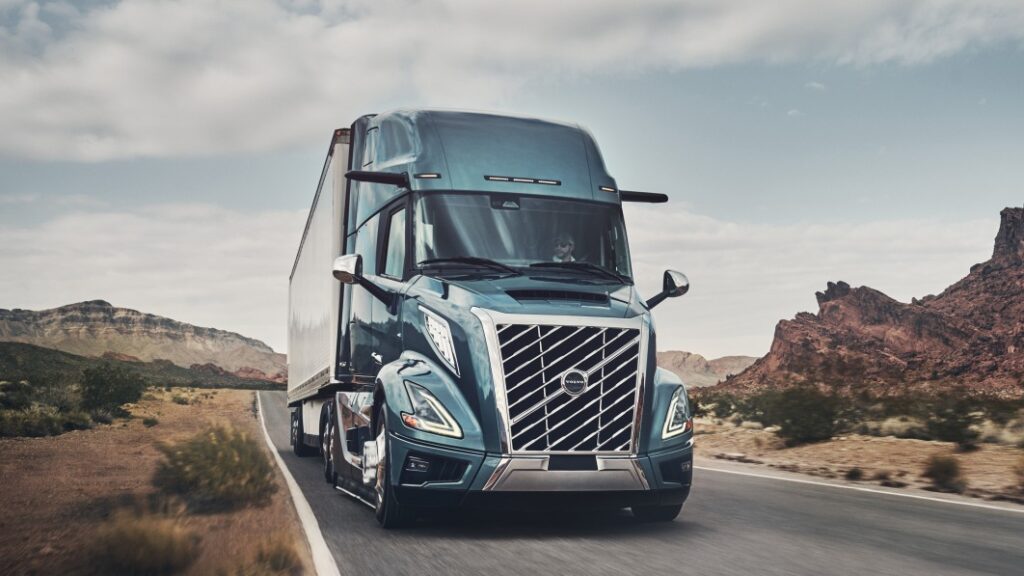All-new Volvo VNL Class 8 tractor loads up on car-like features

A few months ago, we wrote about the public-private partnership between the U.S. Department of Energy and Class 8 truck makers to create concepts called SuperTrucks. The four manufacturers involved designed lighter, more aerodynamic, and more fuel-frugal trucks to hit escalating freight efficiency targets in each phase of the program. Daimler, Navistar, Peterbilt, and Volvo spent the past 18 months showing the results of the SuperTruck 2 phase while work gets going on SuperTruck 3. This month, Volvo becomes the first of that group to debut an all-new truck incorporating lessons learned in the SuperTruck program. Starting with a clean sheet of paper, the new Volvo VNL is said to be as much as 10% more fuel efficient than before, a stat to get fleet managers and owner-operators to pay attention.
Even carmakers tout a 10% increase in fuel economy, and the benefit — like the size — is so much larger in trucks. Let’s keep it easy and say a solo driver does 100,000 miles in a year in a truck that averages 7 miles per gallon. That driver needs 14,286 gallons of diesel to do those miles; at $4 per gallon, that’s $57,144. If the VNL driver gets 10% better fuel economy and his truck returns 7.7 miles per gallon, this driver only needs 12,987 gallons of diesel, and pays only $51,948. Tell a fleet manager they can save $5,000 per truck, and assuming a sensible purchase price and consistent reliability costs, that fleet manager is going to want to set up a meeting.
Just as with car redesigns, a lot of little changes went into this, some we’ll recognize from the car world. The VNL’s cab adopts a stronger wedge shape and sharper corners. Instead of the usual large, flat windshield sealed with a gasket, the new VNL gets a curved windshield bonded to the body. Tighter gaps between exterior components like the bumper and hood leave fewer spaces for turbulent, draggy air to develop. Volvo also reworked the area behind the cab to reduce one of the greatest aerodynamic maelstroms, the gap between cab and trailer.
The D13 engine up front is said to be more fuel efficient and more durable, offering a range of outputs from 405 to 500 horsepower and from 1,748 to 1,947 pound-feet of torque. Considering that the first VNL generation lasted 22 years before a major redesign, from 1996 to 2018, Volvo incorporated powertrain flexibility into this one. The company says the all-new platform is ready “for all upcoming technologies, including battery-electric, fuel cell and internal combustion engines running on renewable fuels including hydrogen.”
As part of that, internal systems shifted from a 12-volt architecture to 24-volt. The extra juice powers the ancillaries that deliver a range of active and passive safety systems, and driver comfort features. These include pedestrian and cyclist detection, automatic emergency braking, and an automatic E-Call system to get emergency responders to the truck’s precise location without needing driver input. For the driver, there’s a suite of ADAS like Active Driver Assist Plus with Pilot Assist, including a lane-centering feature to keep 73 feet of rig stable in crosswinds, on soft shoulders, on highways with high crowns, and during emergencies like a tire blowout. Even better for everyone, the Volvo Parking Cooler employs that 24-volt battery system to run the cab’s climate control when parked, eliminating the need to idle. More than a few freight operators don’t let a company driver’s truck idle when inside a pretty wide temperature range, making for some uncomfortable hours while waiting perhaps days for a load.
And yes, the new architecture lays the groundwork for the VNL to “be the standard for the future commercialization of fully autonomous trucks.”
If you’re into trucks, there’s so much more to the VNL like push-button start, a MyTruck app with stat pages (can’t wait to see drivers comparing stats at Pilot), maintenance updates, and remote climate control activation, an industry-first driver’s airbag, better cab insulation for reduced NVH, a bigger refrigerator, a standard Murphy Bed setup that turns into a dinette area, “and enough power options to support any device.” Big rig, big win.



